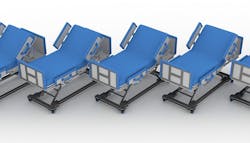Shopping for beds, mattresses extend beyond comfort, costs
What are some of the key factors that providers should consider when comparing, evaluating and purchasing beds and mattresses from the perspective of maintenance – including cleaning, disinfecting, sterilizing, repair and even replacement?
Experts share their tips with Healthcare Purchasing News.
Edmond A. Hooker, MD, DrPH, Professor, Department of Health Services Administration, MHSA, Associate Director for Accreditation, Xavier University
- All major manufactures’ instructions for use (MIFUs) that are compliant with FDA Reprocessing Guidance are similar in terms of the number of cleaning and disinfection steps, internal inspection requirements and replacement of outer cover at the end of the expected life. Demand that the salespeople provide this information in writing before deciding. Do not depend on verbal promises.
- Ensure that all key stakeholders (Environmental Services, Infection Control, Wound Care, Facilities, Finance) are involved in the purchasing decisions. Require all promises to be made in writing.
- Get a commitment from hospital leadership to allow Environmental Services the required time to correctly reprocess the bed/mattress using the required multi-step process.
- nderstand that most manufacturers only warrantee their mattress for one year, and we have shown that many mattresses will fail starting soon after that time. All mattresses must be opened and inspected after every patient to ensure they have not failed.
- Many hospitals are using bleach to kill Clostridioides difficile. Unfortunately, concentrations of 5,000 PPM of bleach are required to kill C. diff spores. Some MIFUs do not permit this level of bleach to be used without rinsing.
- For more information, click here: https://cdn.ymaws.com/npiap.com/resource/resmgr/s3i/S3i_NPIAP_Cleansing_Disinfec.pdf
Iwain Lam, President and CEO, Surface Medical Inc.
- What material is the mattress cover made from?
- Can the mattress cover be repaired or replaced when damaged?
- What cleaners are compatible with the mattress cover?
- What is the anticipated service life of the mattress and cover?
- How comprehensive are the maintenance guidelines provided by the manufacturer?
Don Rotter, RD&E Program Leader, Healthcare Infection Prevention, Ecolab
- End users should look for equipment that is designed with routine cleaning and disinfection in mind, where the manufacturer has evaluated the compatibility of products widely available in the regions in which those products are sold.
- Equipment should be easy to manipulate for the purpose of cleaning, disinfection, and inspection and should be constructed of materials that can withstand the routine cleaning and disinfection with sporicidal chemistries that have become instrumental in proactive infection control strategies.
- Impermeable mattress covers may offer a potential to protect against damage and fluid ingress to the core product and could be considered for some applications.
Linda Lybert, Founder/Executive Director, Healthcare Surfaces Institute Inc.
- Can these surfaces be cleaned and disinfected using hospital-grade disinfectants without causing damage?
- What is the expected life cycle of the mattress and components?
- Have the surfaces been tested using all categories of disinfectants, get data and validation?
- Evaluate [whether] the IFU is consistent with Infection Prevention Guidelines used within the facility.
- Do they provide training for staff around the cleaning and disinfection process for the bed and mattress?
David Willoughby, Vice President, Marketing & Business Development, Medtrica Solutions Ltd.
- There are several very important factors that need to be considered when evaluating and purchasing a mattress from the perspective of maintenance, two of which are durability and performance, that when combined, provide both superior patient comfort and safety.
- Good quality materials, when used in a mattress, not only reduce pressure-related injuries, dishing and thermal build-up issues but can also withstand proper application of CDP. They are way less likely to experience premature cover or core failure.
- Another important consideration that goes hand in hand with durability and performance is the implementation of an effective mattress auditing program that identifies not only the effectiveness of CDP but also identifies those mattresses that require either immediate repair or replacement especially during terminal cleaning.
Jessica Mathieson, General Manager and Vice President, Acute Care, Stryker
- What is the quality of this product?
- How long will this product last?
- Will this product improve our process (cleaning/disinfecting/sterilizing/repair) and/or our facility?
- Can this product be added to our facility without changing cleaning process/procedure and can it take away steps from the process?
James B. Waddell, BLS, ICRA, CSCMP, SW Patient Care Support Manager, Nursing Administration, Capital Service Line Chair, IT Administrator, Unit-Based Fit Tester, Cone Health
- Some main factors to consider when looking at beds and surfaces are safety, durability and reliability of the product.
About the Author
Rick Dana Barlow
Senior Editor
Rick Dana Barlow is Senior Editor for Healthcare Purchasing News, an Endeavor Business Media publication. He can be reached at [email protected].

